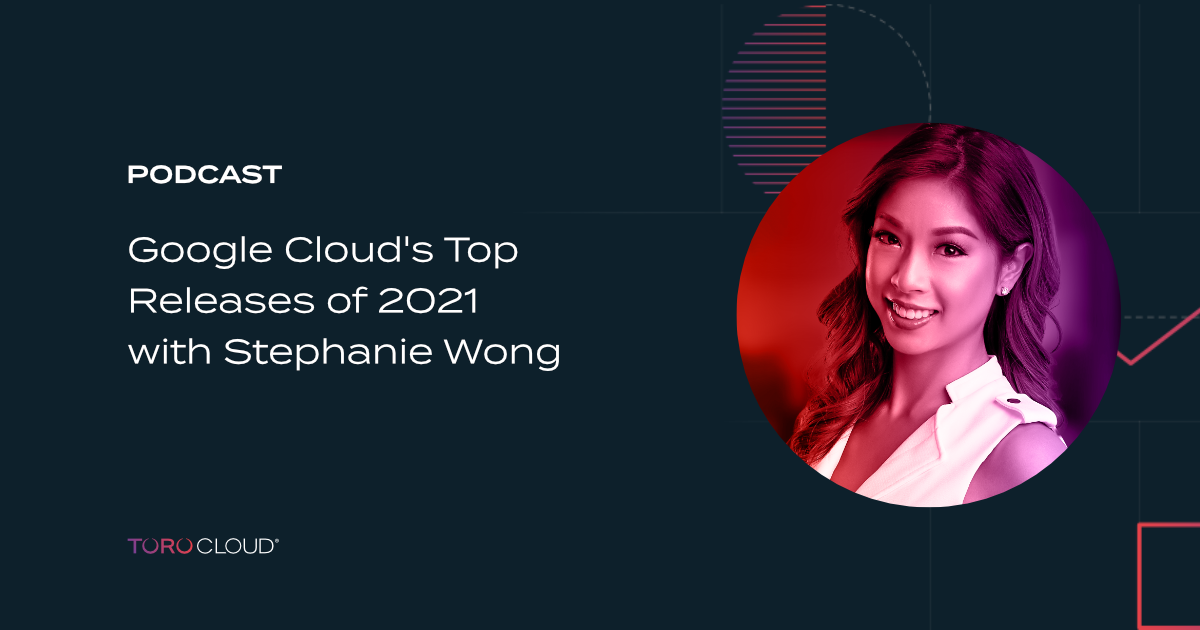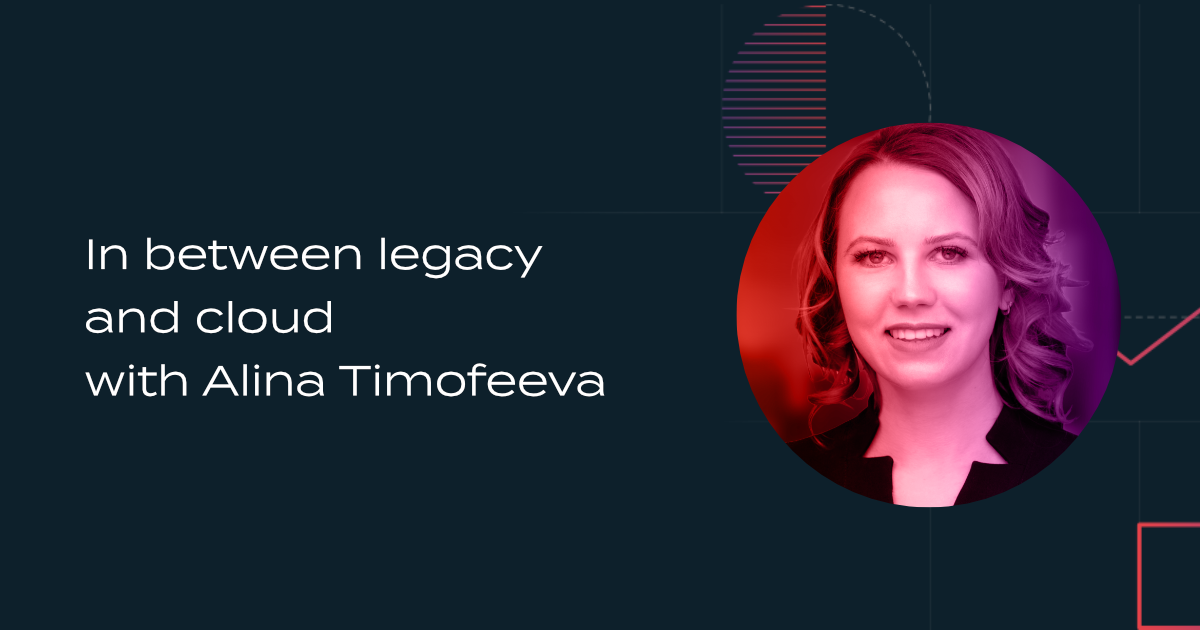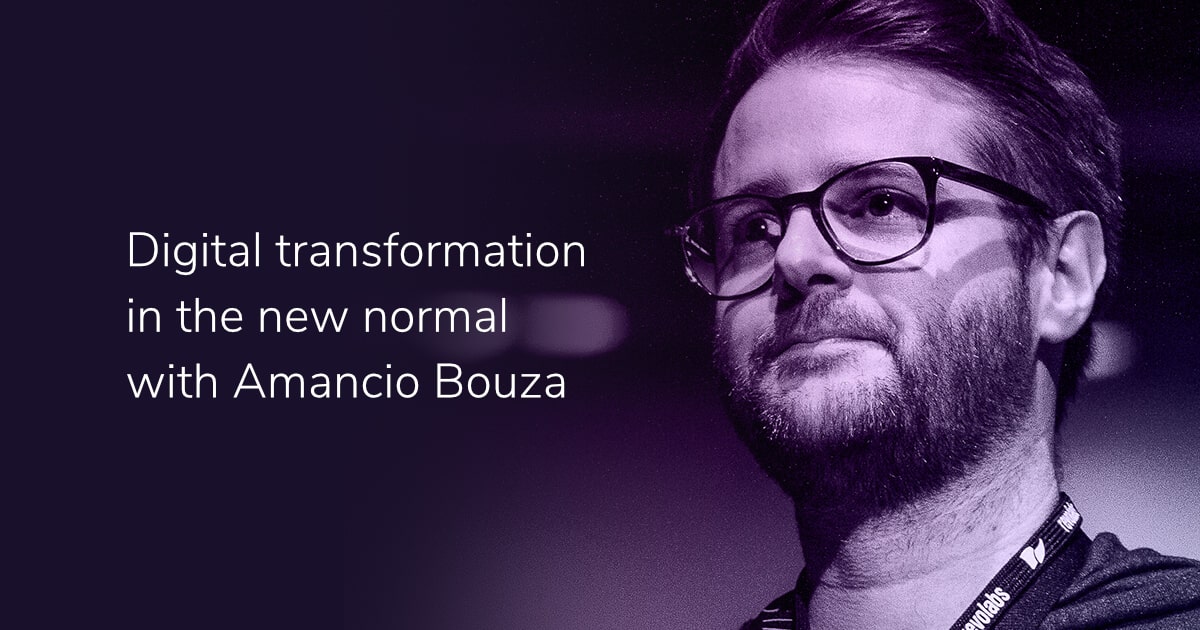
The cloud, and the enterprise IT space in general, is technical and can be very difficult to understand – which is why the role of a Developer Advocate can be crucial to ensure that we’re all up-to-speed with what’s happening and how we can take advantage of new tools and technologies for the enterprise.
In this round of Cocktails, we talk to the Head of Developer Engagement at Google Cloud, who shares with us her background and experience on creating hundreds of pieces of content to promote their products. We also talk about some exciting developments and launches from Google Cloud over the year, and discuss how we can get more women involved in the tech industry.
Episode outline
- Stephanie Wong shares how she went from creating content using webcams and sharing them in her YouTube channel to becoming the host for Google Cloud Next.
- What are the challenges in keeping developers up-to-speed with the latest cloud developments in Google?
- Wong shares some advice on how we could distill messaging and make it easier to digest for our audiences.
- What are some of the exciting developments at Google in 2021?
- How can we foster better diversity and equality in the tech industry?
Transcript
Kevin Montalbo
Welcome to episode 52 of the Coding Over Cocktails podcast. My name is Kevin Montalbo. And joining us from Sydney, Australia is Toro Cloud CEO and founder, Stephanie Wong. Good morning, David!
David Brown
Hi there, Kevin!
Kevin Montalbo
Hello! Our guest for this episode is the Head of Developer Engagement at Google Cloud. As a speaker, writer, and architect, her mission is to blend storytelling and technology to create remarkable online developer content. She’s created over 400 videos, blogs, courses, tutorials, and podcasts, including the Google Cloud Youtube series Networking End-to-End, Discovering Data Centers, and Eyes on Enterprise. She’s also the host of the weekly GCP Podcast and the host of Google’s Next onAir broadcast. She’s also active in her community, supporting women in tech and mentoring students.
Joining us for a round of cocktails is Stephanie Wong. Hi Stephanie, great to have you on the show!
Stephanie Wong
Hello, cheers! Thank you for having me.
David Brown
It's our pleasure.
Kevin Montalbo
Alright, great. So, let's start with the questions. Let's know more about you. You recently shared your path in tech in a talk called “From No-Code to Engineering.” So, what's really interesting about your story in Google is that you actually started a video production aspect of your job as something you did outside of your day-to-day responsibilities. It's a passion project. So, can you tell us about how you went from shooting with webcams in game rooms to hosting Google Cloud Next, Google Cloud's biggest annual event?
Stephanie Wong
Yeah, it's been somewhat of an unconventional path and I definitely did not think I would end up where I am today, leading this initiative within developer relations. I guess, to give some background would be helpful to know that when I went to university, I had no intention of going into technology. Although I had an interest in passion for consumer technology and using technology, I really didn't know what I wanted to do. So, I ended up selecting communication studies as my major, thinking that I was interested in going into entertainment, production, media.
And so upon the job search, I ended up looking at many different companies and I also had a minor in something called digital humanities which is somewhat of a bridge between technology and humanity studies like literature, history, etcetera. So, when I was applying to different jobs, I ended up getting a role at Oracle as a sales engineer, not really understanding what it meant other than this interdisciplinary role that would combine my skills in communication studies and my minor in technology.
So, I decided to take a shot and go for it and ended up enjoying it and kind of always coming back to the thought that I wanted to go into video production and talk about technology, but there really wasn't a field for that unless I wanted to be a tech reporter in the news or a YouTuber. So, I kept that brewing in my mind and when I ended up getting recruited to work at Google as a sales engineer, I decided to explore making videos only because I happened to meet someone within the company in sales engineering as well who wanted to make videos. So, it was sort of a just-happened chance that we both combined our interests, started filming demos, customer stories, interviews and just doing it scrappily using webcams, running around game rooms and lounges and posting it to our own YouTube channel.
So, it's really fun and I had no idea where it would lead and you know, lo and behold, down the line after getting more visibility from those videos, I was asked to start creating it within a fully budgeted and fully funded studio within developer relations because the person who was running that team at the time - well it wasn't a team, it was just more of an idea - he wanted to really grow and invest in that content creation field for developers. So, all I did was continue to stay curious and say yes to higher visibility projects. And that ended up landing me a position in DevRel.
Kevin Montalbo
Yeah. And that landed you in the position of Head of Developer Engagement today. So, can you share with us some of the challenges associated with keeping developers up to speed with the latest cloud developments in Google?
Stephanie Wong
I think one of the biggest aspects of it that I find the most challenging, but also the most motivating, is that we need to be able to bridge legacy technologies with modern architectures.
It is very challenging because as you know, cloud is ever-changing. When I first started my career in cloud seven or so years ago, it was very different from what it is today. So, I think one of the biggest aspects of it that I find the most challenging, but also the most motivating, is that we need to be able to bridge legacy technologies with modern architectures, involving new things like microservices or service-based networking, API management and also the ways that companies can modernise how they create products using things like machine learning and AI.
So you know, just staying on top of this ever-changing field is one of the biggest challenges. And on top of that, we also are seeing an influx of new personas in the industry. DevOps, SecOps... Operators, not just developers. We have data scientists, data engineers, UX researchers. There's plenty of new hats that people continue to wear in the field and so being able to create content and tell stories that engage all of these various personas is quite a challenge. But again, I really enjoy doing it.
David Brown
That's interesting. You raised a number of different roles there that you're speaking to. How do you go about educating yourself and staying on top of all these technologies and speaking with authority to these people which are often authorities in their fields themselves?
Stephanie Wong
Yeah, that's really the crux of the job as Head of Developer Engagement and something that I've defined myself over the years. I think it takes a certain type of person who is driven to learn about all of these fields and understand that you can go really far deep in one area or you can go very wide and cover a wide breadth of topics and that's sort of where I fit in. I enjoy getting my hands on many different things and getting the gist of what the new technology is and being able to quickly apply it, play around with it and translate it to these audiences.
For me, I think the way that I've been able to do it is it's really just been practice and continuously learning about these topics. I have not only been a consumer of content, but I've been writing and creating my own content and that forces me to be a learner and a teacher. I think one of the best ways to learn is actually to apply your knowledge and share it with others. And also, just kind of have let go of the ego and admit to people I'm not trying to be necessarily an expert in this domain, but what I am trying to do is empathise with these personas and tell the story that Google is trying to tell and sort of just bring down the walls and admit that I am also a learner, just like you are, so let me give you my perspective on how this launch matters to you, why it should matter to you if you have any feedback for me or if you disagree with my points, I am all ears.
David Brown
You have to experiment with the way you create content and deliver content and get some learnings and change the way you're approaching content delivery.
Stephanie Wong
Yeah, this is a constant process, just like everything else. When I first started creating content, I was just starting to play around with video because that's what I knew. But as times have changed, I also learned that people's learning styles vary dramatically from one person to another. Myself included, I am both an audio and visual learner and I can also read pretty quickly too. But you know, we all have our preferences on top of that. We're seeing so many new SaaS tools and platforms, subscriptions and services. So, we really need to stay on top of tapping into these channels. Even Tiktok for example, because that's where our audience lives.
So, over the years I've really needed to hone in on my delivery of content that's optimised for these channels. The way that I tell stories through video is very different from the way that I tell stories through podcasts or the way that I tell stories through social media. And so, you know, it's easy to spread yourself really thin across them. I think there's a way you can get really good at delivering content.
But another way that I found to be more sustainable as a content creator is, let's think about the problem that you're trying to solve for your audience, whether it is a data scientist or a developer and create something that's truly solving their pain point and then figure out a way after that too, essentially distribute that content across mediums. Can you tweak it just a little bit so that you can make the podcast into a video or can you make it split it up into chunks and make it optimized for social media? So I think there's a way there's like tricks to it that you can reach the widest audience.
David Brown
I might be showing my age here, but given your audience is engineers and architects, are they listening to it on Tiktok?
Stephanie Wong
Yeah well, I actually don't use Tiktok as much as I have just talked about it to be honest, but I think there is definitely an audience there. I was mentoring someone last month who just started out in her career and she got hired at Shopify as one of their first developer advocates. And the reason she got hired is because she had a growing audience on Tiktok. She just did it just for fun basically. And she would make funny skits on Tiktok about web design, web APIs, etcetera and Shopify essentially tapped on the shoulder and said, “Hey we want you to do that, but for Shopify.”
And you know, that just goes to prove that we're seeing a whole flurry of people, creators, leaders that are essentially organically growing their careers and their audiences. And so it's clear to me that yes, there are people on these new platforms and they are watching and they are listening.
Kevin Montalbo
I'm pretty sure David's gonna create a Tiktok out right after this. I remember we had a guest over a few months back who also had the same story. He was a developer advocate at MongoDB and he's now creating Tiktok videos, funny Tiktok videos and sharing them all over Twitter and Instagram. And also I remember like Twitch becoming this really engaging platform not only for gaming but also for developers who want to showcase their products and build tutorials, stuff like that.
David Brown
And it's interesting that the way we started this podcast was not dissimilar. Actually Kevin approached me, he said, “We got that recording studio which we've got back there, which we built for writing tutorials and stuff. Would you mind if I recorded a podcast?” He really just wanted to use the equipment and had done recording stuff in the past and like you, it became a fully resourced dedicated area within our organisation.
Can we talk about some of the product launches that you've done recently? One of them is Vertex AI. You announced it a few months ago now, in May. It’s a unified machine learning platform. So what role does it play? Google has had machine learning capabilities for quite some time. So what is this new one and how does it work with the existing machine learning tool sets available at Google?
Stephanie Wong
Yeah, so just to give some background on it, back in 2018, we released a product called AI Platform and that included training, prediction data, labeling, along with managed notebooks as well. And it handled all of the steps that you needed for a complete machine learning workflow, from sourcing data to managing models and versions. And then alongside that, we also had a popular AutoML offering set, like AutoML Vision, Video Intelligence, Natural Language API.
And so those were essentially pretrained models from Google to help you get started right away. So, the feedback since then that we've gotten is that data scientists have been grappling with the challenge of manually piecing together ML point solutions and this increases a lag time in model development and experimentation and it kind of reduces the number of models making it into production. So, Vertex AI was announced this year to bring together Google Cloud ML services under one unified UI and API to simplify the process of building, training, and deploying these models at scale.
So, you get AutoML and AI Platform in the same underlying infrastructure data models. You know, you can either go the path of using AutoML or you can train your custom code, but you get one central model repository and experience. So, that's sort of the idea behind it from the feedback that we've gotten from the community. And so the goal here is that, you know, you kind of have this, choose-your-own-adventure book so that you can decide whether to train your own models, use AutoML, BigQuery ML and still end up with a productionised model at the end of the day. Meanwhile, your hands never leave these same bound pages of the book essentially.
David Brown
It’s like, as I understand, it's using some of the existing toolsets Google already had but abstracting on top of that, a layer which automatically creates these machine learning models, but it still utilises things like BigQuery, for example, under the covers as well. Correct me where I'm wrong. I'm sure I am. Maybe we could also explain some of the use cases for it and how the use case would differ from AutoML to the standard ML approach.
Stephanie Wong
Yeah, so just to clarify, BigQuery is a separate analytics data warehousing platform but it does have a function within it called BigQuery ML where you can actually run models using BigQuery’s interface and that is a lot easier for somebody who may not have that expertise to create models in a typical ML platform or like TensorFlow.
So yeah, just to describe the use cases, while there are some key features that Vertex AI has like, deep learning VM images, the infrastructure side of things, you also get Vertex notebooks for text data labeling. So you can have a human labeling service to make things sped up for you and easier, explainable AI to help you get insight into your model's performance, Vertex pipelines to create a more operationalised process in creating your models. And then we also just came out with something at Google Cloud Next, which just happened this October, called Vertex AI Workbench and that is a fully managed notebook IDE used for data exploration and data science workflows.
So really, it covers the full gambit of tools and features that you would need as a data science team to successfully train and deploy your own models, monitor them, iterate off of them, run experiments, to do any sort of use case, really. And then the AutoML side is if you want to get started on an easier path using our existing pre-trained models for Vision, image recognition, Video Intelligence, translation, Natural Language and many more. And we also have healthcare ML API, as well as some other things like Contact Center AI and those can be used in conjunction with this platform.
David Brown
Huge. It covers so much ground. And in fact, you had a few product announcements. Another one was called Autopilot. Google Kubernetes Engine Autopilot. So, you know, Kubernetes can be difficult to manage. So how does Autopilot facilitate the management of a Kubernetes deployment?
Stephanie Wong
Yes. So, this was one of our most exciting announcements of 2021 as well, GKE Autopilot as you mentioned. So, this is a new mode of operation for creating and managing Kubernetes clusters in GKE. So in this mode, GKE configures and manages the underlying infrastructure, including nodes and node pools so that you can focus on just the target workloads and pay per pod resource requests. So, that means you're paying for CPU memory and ephemeral storage and one of the best parts is that you get an SLA on the hosts and the control plane and it also includes an SLA on Pods.
So, to give you some background about why I think this is so revolutionary, we really haven't been that shy about the fact that Kubernetes can take a fair bit of manual assembly, tinkering to optimise it for your needs. And GKE was launched in 2015 as this container orchestration platform. So, you can create or resize Docker container clusters, create container pods, replication controllers, job services, load balancers. And so you're probably thinking, “Well, wasn't GKE already fully managed?” And it was a very hands off Kubernetes platform because it managed cluster control planes, storage, and networking, but this was really great for companies with operator teams who wanted to make their own decisions on node configuration and cluster size and auto scaling and things like that.
But as we've come to realise, many teams, especially, you know, smaller teams, are people who are just migrating over to Kubernetes. They might be more overwhelmed or they find that a lot of these controls are unnecessary for their requirements. So, GKE Autopilot was developed to give teams a very straightforward way to build more secure and consistent platforms based on the configurations that we're assigning, so that you can really embrace Kubernetes as this modernisation. But you know, you don't really need to worry about the nodes and the infrastructure management, especially when it comes to really right sizing them as you scale.
David Brown
I think, as you say, it's probably one of the most exciting aspects of the product announcements because from our own experience with deployment, deploying integration, infrastructure and API infrastructure which is often deployed on Kubernetes, that management headache is just something they don't want, you can do without. So, I can definitely see the demand for that one.
The next one that we want to talk about was Dataplex, dubbed an “intelligent data fabric.” How can Dataplex better manage distributed data across an enterprise?
Stephanie Wong
...to be honest, companies are still struggling to move data from various sources and extract metadata.
Yeah, so moving into the data, this data analytic space here. So Dataplex was announced in preview during our Data Cloud Summit earlier this year, in May. And that summit had over 10 other data analytics-related announcements. And at Next, recently, we announced the upcoming GA release of Dataplex for general availability.
So, this is really exciting. It's been dubbed the “intelligent data fabric,” meaning that you get this unified data management platform for your data warehouses and data lakes, data marts and databases. So, what this means is that you can centrally manage and monitor and govern your data across silos and make this data securely accessible to a variety of analytics and data science tools.
So why is this important or why does it matter? I think in tech, we've all heard the words “data silos” enough when it comes to analytics in a conversation. But to be honest, companies are still struggling to move data from various sources and extract metadata. And cleaning and preparing data is still error prone and setting up security policies is laborious. And so, you know, it's hard to achieve that interoperability that you're looking for between data warehouses, open source analytics, engines and SaaS platforms. So, you usually have to make a decision between moving and duplicating data across silos or just leaving your data distributed and having to move slower when you're trying to actually analyse it.
So our goal here is that, [what] we talked a lot about at Next is to just simplify the world of data for our customers. And we want organisations to be able to build an environment where insights can be developed rapidly and data is well governed. It can be trusted, it can be easily discoverable. And so, Dataplex is our manifestation of all of that.
David Brown
How does it manage that process then?
Stephanie Wong
So, some of the key features include an interoperable storage layer. So, it enables logical constructs like lakes and data zones and assets for your various sources that exist in different places. And we also use Google AI to automatically harvest metadata for both structured and unstructured data and you can also define and enforce consistent policies across your data and locations. So, it's really exciting to be able to have this consistent view. I haven't seen very many tools out there that have successfully been able to do it because it's such a complicated challenge, with data existing in different places.
So yeah, I think this is a part of a larger initiative for Google Cloud to offer better data governance across environments. It's built to integrate with many different partners like Apache Kafka Spark, Presto, we're also partnering with Accenture, Confluence, Informatica, NVIDIA, Trifacta. So, we're really putting in an investment to make sure that this works across environments for our enterprise customers.
David Brown
Interesting. Let's talk about the tech industry and your role in promoting women within the industry. You're obviously a key figure within Google and are out there in the public eye. Women are still regarded, despite representation in a number of key CEO roles in the industry now, they're still seen as underrepresented in the industry, potentially underpaid and sometimes discriminated against. What can we do to address this representation of women in the industry?
Stephanie Wong
Discrimination in tech is real, due to things like this idea of “bro culture” sometimes, or even microaggressions that may happen in the workplace.
Yeah, I agree. I think women are underrepresented in tech and in STEM-related positions like computer science. I have colleagues who were the only women in their CS department in college and often felt isolated, which makes sense why retention for women in those departments can be low. And yes, discrimination in tech is real due to things like this idea of “bro culture” sometimes or even microaggressions that may happen in the workplace. And another issue that I see is the pay gap. I still think that's real. I personally started out underpaid compared to male counterparts in the beginning of my career.
But one thing that I'd also like to highlight as a result of a lot of these variables is the lack of women in leadership positions in tech. Women make up almost half of the US workforce, but they hold less than one-third of leadership positions in tech, and that low level pre-dates COVID-19. And since the pandemic started, I think it's become even more pronounced due to increased burden of family and childcare and things like that.
So, just based on my experiences so far, I think I have been somebody who really believes in representing interdisciplinary backgrounds in tech. I, for one, have made it into engineering and a very niche role at that that combines hard and soft skills. And I think that's in large part due to me continuously celebrating my varied background in communications and my passion for technology and you know, even just my interest in performing and dancing outside of work.
So, I think one thing we can do is really encourage people to go for STEM or go for other functions in college and in their careers, even if they don't conform to the stereotype of those roles in tech. And on top of that, we have other roles like business roles, architects, program managers, UX researchers, consultants and more. So, I think we really need to encourage women to go for those roles even if they seem like they have a different background.
I have a lot of other suggestions like, you know, for companies to build career programs and offer free programs or stipends for women to build skills and advance their careers. So, I joined one for example, called “The Forum,” which was not part of Google. It was just another company where women could get together and learn the skills necessary to self-advocate for themselves to get the next promotion, to network better, to feel like they could promote their work without feeling like they're bragging or feel like they're not being humble enough.
So yeah, on top of that, I think companies can also really increase opportunity and funding for employee resource groups like women groups or even, you know, Asian-Americans in tech, for example. So, just having those safe spaces and also just creating a culture of psychological safety. I think that people need to feel included in their environment to be successful and to stay.
So, you know, just making sure that we speak out when you notice microaggressions and never promote a fear-based culture and that goes all the way to leaders, right? I think the leaders need to be very transparent and open to feedback. Everyone should feel comfortable speaking their truth and shouldn't feel like they have fear of retaliation.
David Brown
Totally. If we create that culture and environment within the industry, then perhaps we will get more women entering the industry. Because part of the challenge - I'm not sure about the graduating year in the States - but the number of female graduates that we see in IT is very, very live. And we had a reasonably high proportion of women in our company compared to the percentage of women in the graduating year. There just wasn't that many. But if we create those environments, then hopefully more women would be attracted to the industry as well.
Stephanie Wong
Yeah, that's why I think - sorry, I'm just going to make one last comment - that's why I think mentorship and coaching is so important. I am a really big believer in going back to your previous network, to your alma mater and making sure that you can provide guidance. There's someone in my previous university, UCLA, who reached out to me because she saw that I was in communication studies and I still ended up working in engineering at Google and she was like, “I'm an artist, I don't have that CS degree, but I have done, you know, CS classes. I really want your guidance and you know, making me feel like I belong in tech even though I haven't graduated yet.” So, just making sure I can be that mentor for her and an influence has been, you know, really, really, I think, inspirational for her and if I can help one person then that makes all my time worth it.
David Brown
Wow, I'm sure you're helping more than one, Stephanie. How can our listeners follow what you're reading and writing about, which is a lot? So, what are the best channels to follow you?
Stephanie Wong
Yeah, so, well, my website is Stephrwong.com. I would say follow me on Twitter, that's where I put out all my new stuff and that's “@stephr_wong.”
David Brown
Great! Stephanie Wong, thank you so much for joining us today. It's been a pleasure to have you on the show.
Stephanie Wong
Thank you so much, David and Kevin! Hope to talk to you again soon.











